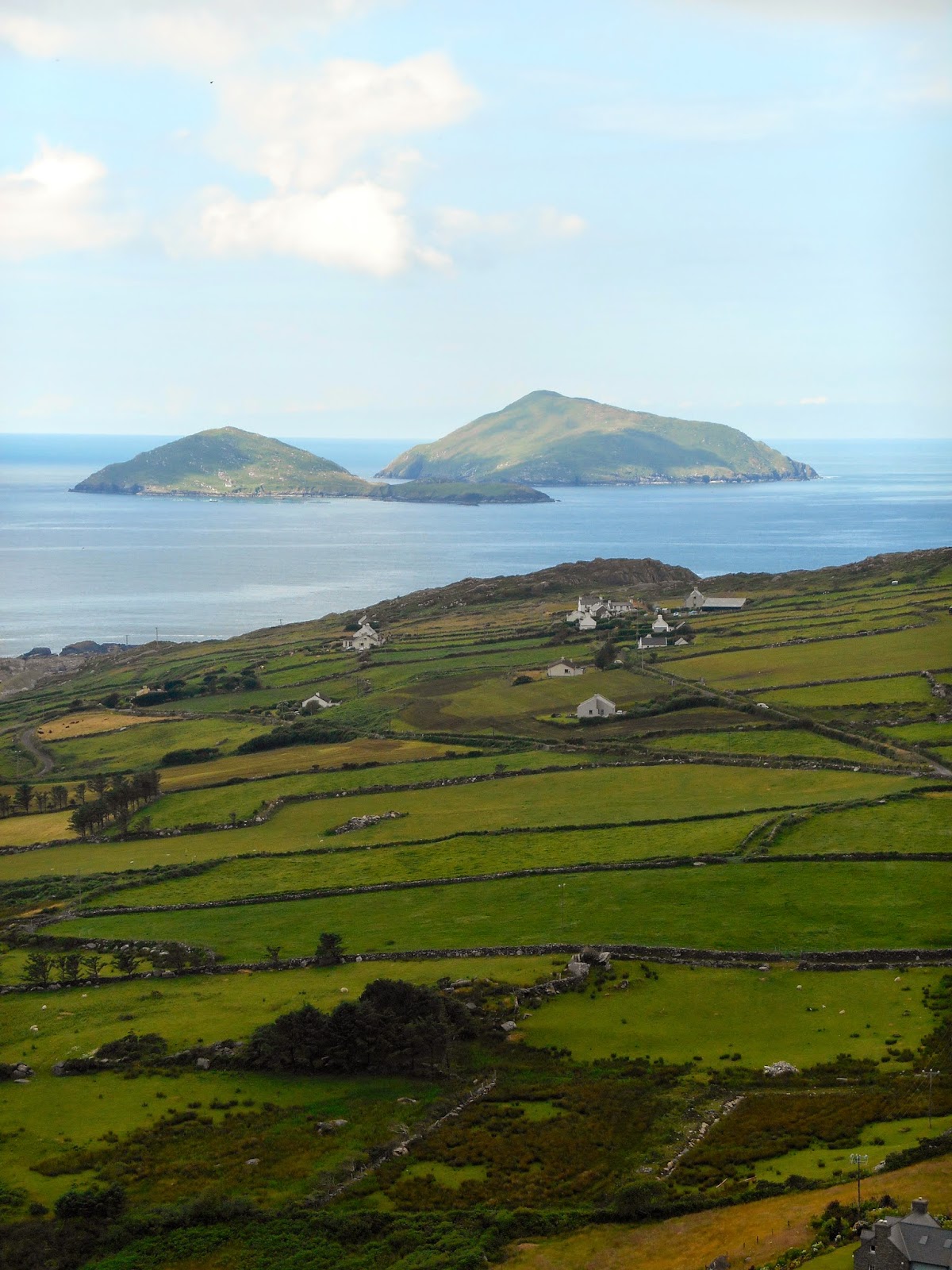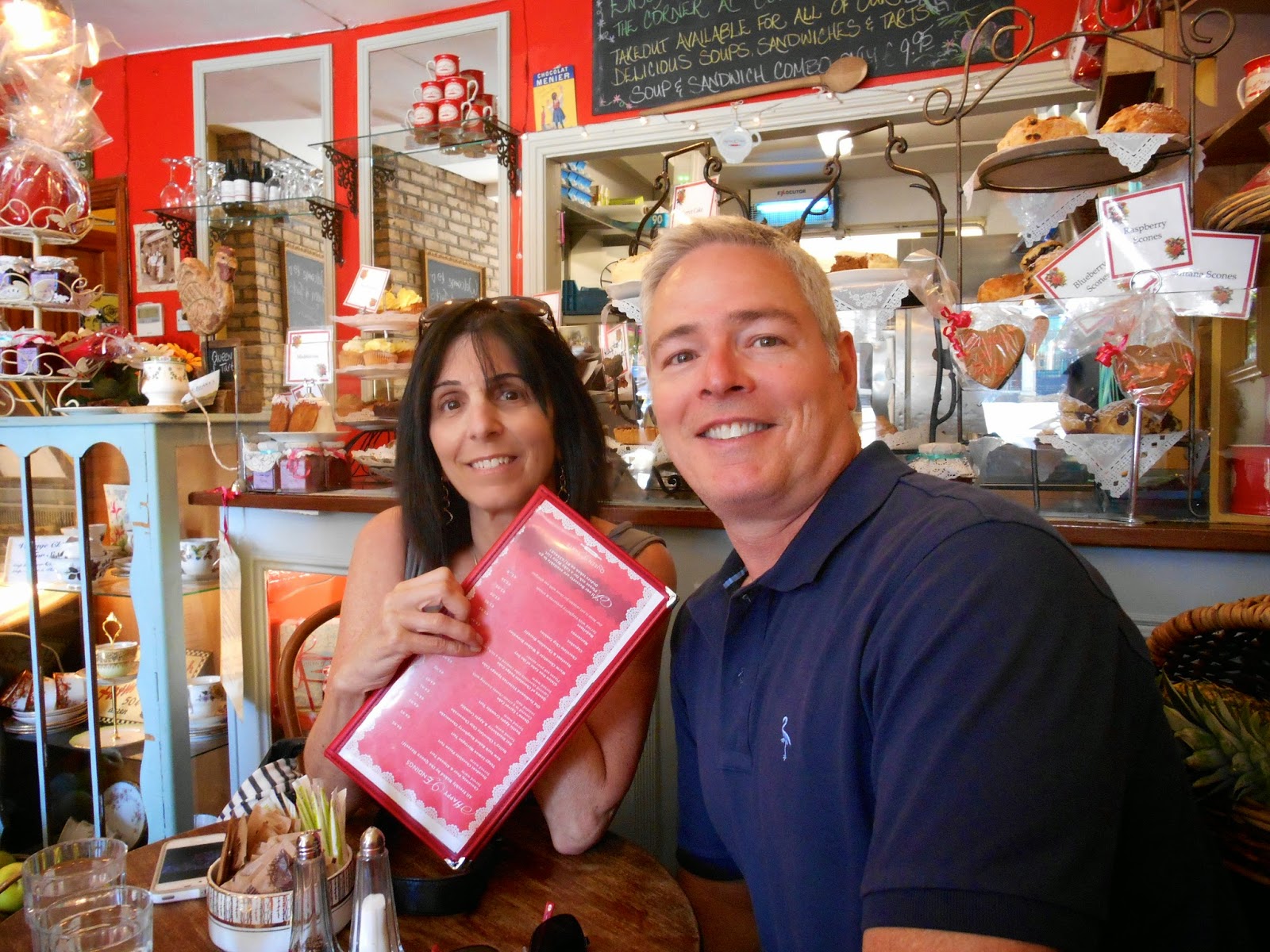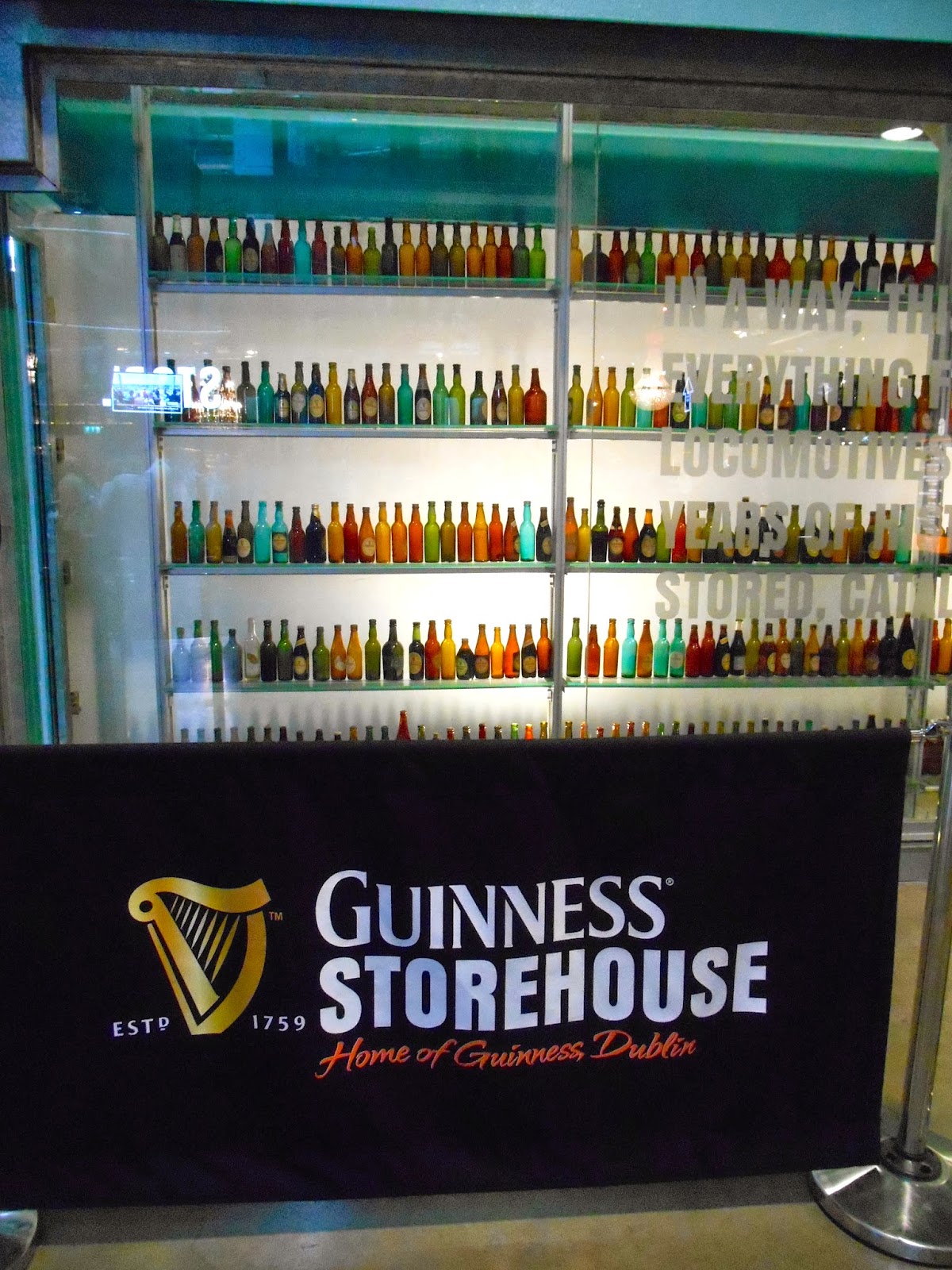
We have been told by many of the people we meet, and it has been proven to be true, that the Irish talk a lot about the weather. So now I will do the same. When we were planning this trip we assumed that it would rain a lot and hoped for the best. Jim's cousin Andrea emailed us a week prior to our flight and just summarized: "pack for everything except snow." And that is what we did. Since we have arrived we have been most pleasantly surprised - the weather has been wonderful. In the 60s and 70s, either sunny or partly cloudy save a few brief drizzles the first few days. One of our tour guides (at Kilkenny Castle) explained that if it is the least bit warm or sunny, the Irish are outside. Explains the throngs of people heading to the Sandy Cove beach last week to dive into the 55 degree water! We daily track our weather apps on our phones before we make our plans, and while the 5-day predictions change almost hourly, we had stopped even thinking about taking an umbrella. But yesterday (Wednesday) we went in to Dublin and it began to drizzle lightly, and once we got home it was more "rain". So, today (although so far no rain) we are just taking a day to kick back and relax, as we had a busy couple of days.
So, to get you all caught up...
Back in Time:
On Saturday we drove about an hour north of Dublin to New Grange. This is the site of a "passage grave" and mound. Built in around 3200 BC, it was not excavated until the 1960s. Archeologists then discovered that at dawn on the winter solstice (Dec 21) rays of sun enter the tomb and light up the burial chamber.
 |
A short walk over this river took us from the entrance to
the shuttle bus to the site. |
 |
| A view from the path leading up to the mound |
The walls around the mound were rebuilt using the stones found at the site.
Entrance to the mound is only through the tour. Groups of 16 go inside at a time due to small size of the passage and chamber
Below you can see the entrance to the passageway.
Above the entrance is the roof box through which the beam of sunlight travels on the winter solstice.
The elaborately carved stone stands in front of the entrance. The tri-spriral carving has many different interpretations, which the tour guide explained and left it up to us to choose the one we thought was best. This design also appeared inside the chamber.
Once we went through the VERY narrow and low passage we found the chamber itself to be surprisingly roomy. The winter solstice is then recreated for our visitors pleasure - amazing.
A lottery is held to be one of the 16 people who can be inside for the brief moments on the winter solstice - of course, even if you get to be one of the 16, it all depends on the weather - if the sun isn't shining, then the "event" doesn't happen!

In the area surrounding, were other burial mounds. We had noticed similar mounds off in the distance when at Stonehenge in 2010, and wondered what they were, so this was a great opportunity to get a close up view and understand what they are and see the inside.
 |
| Around the site were other structures |
And beautiful views of the Irish countryside

From there we drove to Malahide Castle. This burial ground helped us to transition from ancient burial site to "modern" castle.

Malahide was built in the 14th century as a fortress, but later (and until 1973) became the residence of the Talbot family
The grounds were lovely
including this unique hideaway that Gilles discovered
Medieval Town:
On Sunday we took another day trip to Kilkenny, about 1.5 hours south of where we are staying. We toured the castle, built in the 12th century, primarily occupied by the Butler family (Marquesses and Dukes of Ormand). Probably the most interesting bit of trivia offered up by the docent was that when the Butler family decided they were no longer interested in owning the property (which was in complete disrepair) the property was put up for sale, and sold to the city of Kilkenny. Apparently the day of the ceremony to celebrate the sale, Mick Jagger was in town and commented that he wished he had known it was up for sale because he would have bought it. The citizens of Kilkenny are glad that didn't happen. However, Jagger has maintained his interest in the area and is an occasional visitor.
 |
| The "smaller" house/residence of the Butler family |
We headed in to the village for lunch
Very charming streets and shops, although many were closed for Sunday.




While we were having lunch, this group of kids showed up with their violins to "entertain" us. They were not very good, but they did gather up some Euros that sympathetic folks dropped into their open violin case. I was a little horrified that the mother set them up there and then took off, and the idea that they were playing for money...but there were similar groups along the street with proud moms standing by. So after coming up with various possible scenarios we decided to think optimistically and settled with the theory that they were from the nearby music institute and were just getting practice playing in public...Of course, quite interesting that the spot the mother chose for them was in front of Kyteler's Inn - built in the 13th century and one of Ireland's oldest inns. Story has it (and you know about the Irish "stories") is that Dame Alice de Kyteler was the daughter of a banker, married four times amassing a fortune, while each husband died of "suspicious circumstances". She was accused of witchcraft and tried in what is understood to be Europe's first witchcraft trial. She was sentenced to be burned, but her "connection" to local gentry ensured her escape to England...
On a more spiritual note...we passed this pub on the way back to the car:
 |
In case you can't read the fine print: "Bravo
Bartholomew, the Field is a great place
to have supper. We must come back"
|
More of Dublin:
On Monday we headed back into Dublin (we are beginning to recognize the bus drivers) and started out at St. Stephen's Green - and a return visit (as we did in 2010) to the James Joyce statue there.
 |
Here I am surrounded by James Joyces
(I prefer the live version on my left) |

We found our way to St Patrick's Cathedral - rebuilt (was original site of a Norman church built in 1191) in the early 13th century. Irish writer Jonathan Swift was the Dean of the church from 1713-45 and is buried there.
 |
| Swift's grave along with his "partner" Stella |
 |
| City Hall Rotunda |
We headed next to City Hall - built in 1769. It was one of the buildings occupied during the Easter Uprising of 1916. In 1922 it became the temporary headquarters of the Irish Provisional Government under chairman, Michael Collins, whose funeral was also held there.
The day prior, Kevin had been emailing with us and forwarded a suggestion from Taylor to eat at "The Queen of Tarts". She has not been to Ireland, but had seen it on Instagram.
As it turned out, it was right across the street from City Hall, so we headed there for lunch.
So just to say a bit about the food...OMG, we have never eaten so much bread, pastry,scones, etc.
And the Queen of Tarts provided ample of all of that, as well as fabulous soups, sandwiches and salads.
From there we did another return visit from 2010. We had been so impressed with the Chester Beatty Library museum, that we wanted to go back. His collection of artistic treasures of the cultures/religions of the world is huge, so they rotate items through, so exhibits always are changing. It is an amazing collection of manuscripts, prints, icons, small paintings, and early printed books from across Asia, the Middle East, North Africa and Europe. Loved it just as much as last time
 |
| The Chester Beatty Library - on the grounds of Dublin Castle |
From there we saw signs for an exhibit entitled "Ulysses Cylinders" at the Carriage House building behind Dublin Castle. Since we are doing all things James Joyce on this trip, we had to explore. Turns out it is a Dale Chihuly (glass sculptures) exhibit - and we love him. Apparently he and artist Seaver Leslie developed a fascination with Joyce's Ulysses and in the 1970s began exploring creating an overview of the episodes of the book via glass and art. In the summer of 2013, they decided to revisit the idea. With Leslies' drawings on paper, they adapted the sketches into fragile glass drawings. It helped Jim (and maybe even me) to get closer to reading the book! Stunning exhibit.
We were feeling bad that after all of the time we had spent in Dublin, we had yet to take Janet and Gilles to see the Liffy or even go over it to the north side of the city.
As we walked over the Ha'penny Bridge, we noticed these clusters of locks. Janet and Gilles explained that this has become a huge problem in Paris on the bridges over the Seine - couples or friends putting up engraved locks as a testament to their love/friendship. Apparently causing the cities lots of hassle and money to remove them, and even "weighing down" some of the bridges.
We ended the day with MORE James Joyce...
Gilles makes use of a cane for walking, but hadn't brought his because he wasn't sure if he would be able to bring it on the plane. So instead he brought along an old ski stick figuring he wouldn't care if it was confiscated. It was not, but it broke the day before, so he thought maybe he could just swipe Joyce's!
A jail, some art (?), and time for beer:
Tuesday we ventured out to a part of Dublin we hadn't visited during our last visit. Our tour guide on Friday had promoted seeing Kilmainahm Gaol - the prison that housed many of those involved in the fight for Irish independence. This was one of the most historically interesting and emotionally moving places that we have visited.
It was built in 1796 and was an operating jail up until 1924. The last prisoner held there during the Irish Civil Way was Eamon de Valera, the future President of Ireland.
During the famines, the British outlawed public begging, so many poor, homeless people (men, women and children) ended up here. As horrible as the jail conditions were, many felt it was better than being on the streets and at least might get one meal/day.
This is the front entrance to the jail. Initially the area above the top windows was used for public hangings.
 |
| Cell door in oldest section of the prison |
This corridor of the jail was the most significant in the fight for a free Ireland. In 1916, on Easter Sunday, a group of rebel leaders decided it was a good time (with England distracted by WWI) to try and take over the British rule in Ireland. So in a somewhat organized effort, the group of rebels took over various government buildings throughout the city. The most knows was the take over of the General Post Office. Things went badly, and the rebels were met with a surge of British troops, and the 16 leaders of the revolt were arrested and taken to Kilmainham. Initially, the rebels did not have much support among the citizens of Ireland. But what happened at the jail changed all of that. One prisoner, Joseph Plunkett, requested a marriage ceremony to his fiancé Grace Gifford. Several hours later he was executed before a firing squad. James Connolly, who had been severely wounded during the battle at the post office, was moved from the hospital to the jail and, unable to stand for execution, was tied to a chair and then executed. All of the 16 leaders were executed. When word was spread about these atrocities, the public opinion changed to be in favor of the fight for independence. The tour took us through the jail, and at the end was a three level political museum. Very emotional - filled with letters written by prisoners, lockets of hair from the 16 executed, letter from an 18 year old the day of his execution, newspapers from the Easter Uprising and the executions that followed, etc.
 |
Our tour guide pointed out that the "newer" part
of the jail has the same design as the shopping
mall at St. Stephen's Green
(and many other malls around the world)
designed so that from one vantage point
you can see everything - good for prison
guards and shoppers! |
 |
| I guess Jim wouldn't have lasted long! |
 |
The Stone Yard - also where the executions
by firing squad took place |
 |
Memorial to those executed after the Easter
Uprising |
 |
| Memorial outside of the jail |
After that somber but touching experience, we thought we needed something to lift our spirits and headed across the street to Museum of Modern Art
 |
| Impressive from the outside, yes? |
 |
Some of you may have seen this on Jim's Facebook
page with his comment: "I don't know what to say...
this was hanging at the Museum of Modern Art" |
 |
| My favorite exhibit was on the lawn as we left... |
All that was left in the day was to go to the Guinness Storehouse. While the architecture and design elements were interesting - inside it is like walking walking into a large glass pint (5 stories high) atrium - mostly it is a big advertisement for Guinness
 |
Huge installations explain how their stout is brewed
including this water display, explaining the importance of
using good water from the Wicklow Mountains |
 |
A great view form the bar at the top - the building is in the middle
of the St James Gate Brewery - the original house of Guinness.
The buildings cover 4 acres and dominate this area of the city.
Guinness is considered a very important figure in the city as he
has been a major donor. |
 |
Free tasting for our efforts (although I really don't like beer/
ale/stout - whatever it is called!) |
On Wednesday:
With Janet and Gilles heading back to Paris in the afternoon, we headed back into Dublin to see the Georgian House Museum. Particularly in the south side of the city, the Georgian architectural influence is seen in the many townhouses. While they were initially built as homes for the wealthy and for politicians, during times of poverty many were divided up into one room tenement apartments, with many family members living in a small room. Currently it seems that many are now converted in to office buildings. Several have been restored into how they originally looked. So sort of a behind-the-scenes look at how middle-class Georgians lived. The one we saw was built in 1794.
Here are a few photos from the surrounding area:
 |
| Whimsical sculpture in Merrion Square |
 |
| Townhomes around Merrion Square |
 |
| Signature doors of many colors |
It was time to head back and let Janet and Gilles say goodbye to "our" Churchtown Village home.
So that brings you up to date! Tomorrow we head off to a one (or two?) night trip to see Cork and the Ring of Kerry and Dingle peninsula...so keep your figures crossed for good weather as these places are all about the views.













.jpg)


































































































